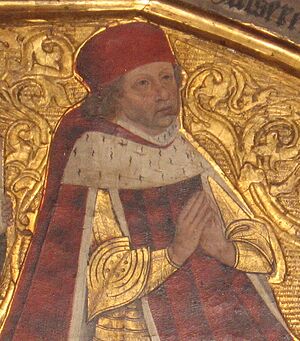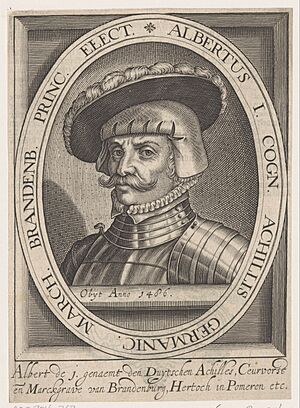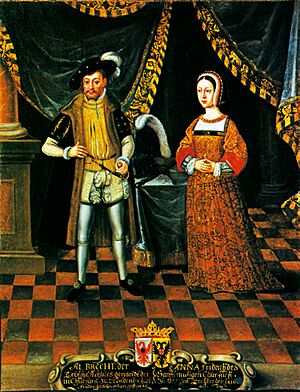Albrecht III Achilles facts for kids
Quick facts for kids Albrecht III Achilles |
|
|---|---|

Portrait of Albrecht Achilles,
St. Gumbertus, Ansbach (1484) |
|
| Elector of Brandenburg | |
| Reign | 10 February 1471 – 11 March 1486 |
| Predecessor | Frederick II |
| Successor | John Cicero |
| Born | 9 November 1414 Tangermünde, Brandenburg |
| Died | 11 March 1486 (aged 71) Imperial City of Frankfurt |
| Burial | Heilsbronn Abbey |
| Spouse |
Margaret of Baden
(m. 1446; died 1457)Anna of Saxony
(m. 1458) |
| Issue Detail |
|
| House | Hohenzollern |
| Father | Frederick I, Elector of Brandenburg |
| Mother | Elisabeth of Bavaria-Landshut |
| Signature | |
Albrecht III (born 9 November 1414, died 11 March 1486) was a very important ruler in Germany. He was the Elector of Brandenburg from 1471 until he passed away. He was the third ruler from the House of Hohenzollern family to hold this title. People called him Achilles because he was known for his brave and knightly qualities, just like the famous Greek hero. He also ruled over two smaller areas in Franconia, called Ansbach (from 1440) and Kulmbach (from 1464).
Contents
Albrecht's Life Story
Growing Up
Albrecht was born in a place called Tangermünde in Brandenburg. He was the third son of Frederick I, who was a powerful leader from Nuremberg, and his mother, Elisabeth of Bavaria-Landshut.
When Albrecht was very young, his father was given the important title of Elector of Brandenburg by the Holy Roman Emperor, Sigismund. This meant his father had a big say in choosing the next emperor.
Albrecht spent some time at Emperor Sigismund's court. He also fought in the Hussite Wars, which were religious wars at the time. He helped Emperor Sigismund's successor, Albert II of Germany, against the Hussites and their allies from Poland. In 1435, Albrecht and his oldest brother, John, went on a special trip to Jerusalem.
Ruling in Franconia
When his father died in 1440, Albrecht and his brothers divided the family lands. Albrecht received the area called Ansbach. Even though he didn't have many resources, he quickly became a leading prince in Germany. He was especially known for trying to stop towns from becoming too independent and ruling themselves.
Albrecht wanted to bring all of the old Duchy of Franconia under his control. In 1443, he created a group to go against the city of Nuremberg, which his father used to have some control over. In 1448, he found a reason to attack Nuremberg. He won some early battles in what was called the First Margrave War. However, he was later defeated and had to sign the Treaty of Bamberg in 1450. This treaty made him give back all the land he had taken and accept that Nuremberg and its nearby towns were independent.
Albrecht was a loyal supporter of the Holy Roman Emperor, Frederick III. In return for his loyalty, Emperor Frederick gave him many special rights, including important legal powers. This made some of his neighbors quite annoyed.
In 1457, Albrecht arranged for his oldest son, John, to marry Margaret. She was the daughter of William III and had claims to the thrones of Hungary and Bohemia. Albrecht hoped this marriage would help his family gain control of these kingdoms, but it didn't work out. He also tried to become the Duke of Franconia, but this didn't happen either.
There were many disagreements among the princes about how to reform the Holy Roman Empire. This led to the Bavarian War from 1459 to 1463. Albrecht faced a group of powerful leaders, including Frederick I and Louis IX of Bavaria-Landshut. Even though he was defeated in this war, Albrecht kept fighting against Prince-bishop Rudolf II of Würzburg. He even made an alliance with his former enemy, King George of Poděbrady of Bohemia. Because of this, Pope Paul II placed a ban on him, which was a very serious punishment from the church.
From 1460, Albrecht lived mostly in Ansbach. When his brother John died in 1464, Albrecht also inherited the Principality of Kulmbach.
Becoming Elector of Brandenburg
In 1471, Albrecht became the Elector of Brandenburg. This happened because his other brother, Frederick II, gave up the title the year before. Now, Albrecht was the sole ruler of all the Hohenzollern family lands. He quickly started working hard to manage them. In 1472, he signed the Treaty of Prenzlau, which ended a war and brought the Duchy of Pomerania under his control.
Albrecht also made a rule in February 1473 called the Dispositio Achillea. This rule said that the main area of Brandenburg would always go to the oldest son. The younger sons would receive the family's lands in Franconia. This was important for keeping the main part of the family's power strong.
After trying to arrange a marriage between one of his sons and Princess Mary of Burgundy (a very rich heiress), Albrecht gave the job of ruling Brandenburg to his oldest son, John Cicero. Albrecht then went back to his lands in Franconia.
Albrecht spent his later years focusing on the affairs of the Holy Roman Empire. Even though he was very sick, he took part in the election of a new king in 1486. This election chose Maximilian of Habsburg as the King of the Romans in Frankfurt Cathedral. A few weeks later, in March, Albrecht died in Frankfurt. He was buried in the Heilsbronn Abbey church near Ansbach. He left behind a lot of wealth.
Family and Children
Albrecht was married two times. His first marriage was on 12 November 1446 to Margaret of Baden. She was the daughter of Jakob I of Baden. From this marriage, they had these children:
- Ursula (born 1450, died 1508), who married Duke Henry I, Duke of Münsterberg-Oels.
- Elisabeth (born 1451, died 1524), who married Eberhard II, Duke of Württemberg.
- Margareta (born 1453, died 1509), who became an abbess (a leader in a convent) at Hof.
- John Cicero, Elector of Brandenburg (born 1455, died 1499).
Margaret died in 1457. In 1458, Albrecht married Anna, who was the daughter of Frederick II, Elector of Saxony. Their children were:
- Frederick I (born 1460, died 1536), who became Margrave in Ansbach and Bayreuth.
- Amalie (born 1461, died 1481), who married Kaspar.
- Barbara (born 1464, died 1515), who married Duke Henry XI of Głogów and later King Ladislaus II of Bohemia and Hungary.
- Sibylle (born 1467, died 1524), who married Duke Wilhelm IV of Jülich and Berg.
- Siegmund (born 1468, died 1495), who became Margrave in Bayreuth.
- Dorothea (born 1471, died 1520), who became an Abbess in Bamberg.
- Elisabeth (born 1474, died 1507), who married Count Hermann VIII of Henneberg-Aschach.
- Anastasia (born 1478, died 1534), who married Count William IV of Henneberg-Schleusingen.
Marriages of His Children
In 1474, Albrecht arranged for his daughter Barbara to marry Duke Henry XI of Głogów. When Duke Henry died in 1476, he left his lands to Barbara. However, Henry's relative, Duke Jan II of Żagań, disagreed with this.
With help from King Matthias Corvinus of Hungary, Jan of Żagań attacked Brandenburg. At the same time, the people of Pomerania also started a revolt. Because of these problems, Albrecht returned to Brandenburg in 1478. He made the Pomeranians accept his rule again. After a tough fight, he managed to secure some of Duke Henry's lands for his daughter Barbara in 1482.
See also
 In Spanish: Alberto III Aquiles para niños
In Spanish: Alberto III Aquiles para niños



